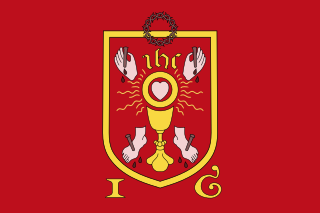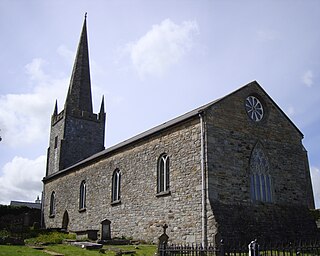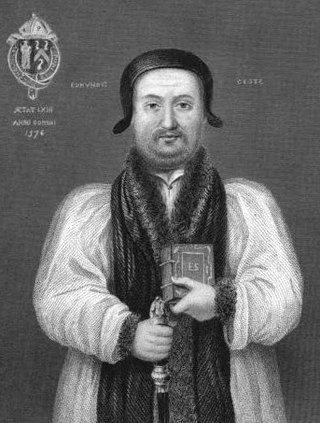Related Research Articles

The Rt. Rev. William Bedell, D.D., was an English Anglican bishop who served as the 5th Provost of Trinity College Dublin from 1627 to 1629. He also served as Lord Bishop of Kilmore and as a member of the Irish House of Commons from January 1628 to July 1628.

The Pilgrimage of Grace was a popular revolt beginning in Yorkshire in October 1536, before spreading to other parts of Northern England including Cumberland, Northumberland, Durham and north Lancashire, under the leadership of Robert Aske. The "most serious of all Tudor period rebellions", it was a protest against Henry VIII's break with the Catholic Church, the dissolution of the lesser monasteries, and the policies of the King's chief minister, Thomas Cromwell, as well as other specific political, social, and economic grievances.

The Bishop of Killala is an episcopal title which takes its name after the village of Killala in County Mayo, Ireland. In the Roman Catholic Church it remains a separate title, but in the Church of Ireland it has been united with other bishoprics.
Heber MacMahon was bishop of Clogher and general in Ulster. He was educated at the Irish college, Douay, and at Louvain, and ordained a Roman Catholic priest 1625. He became bishop of Clogher in 1643 and a leader among the confederate Catholics. As a general of the Ulster army, he fought Oliver Cromwell at the Battle of Scarrifholis in 1650. He was defeated, taken prisoner and executed the same year.

Edmund Gheast was a 16th-century cleric of the Church of England.

The Bishop of Ferns is an episcopal title which takes its name after the village of Ferns in County Wexford, Ireland. In the Roman Catholic Church it remains a separate title, but in the Church of Ireland it has been united with other bishoprics.
Francis Mallet was an English churchman and academic, and chaplain to Mary Tudor.
The Bishop of Waterford and Lismore is an episcopal title which takes its name after the city of Waterford and town of Lismore in Ireland. The title was used by the Church of Ireland until 1838, and is still used by the Roman Catholic Church.
William More was appointed Bishop of Colchester to deputise within the Diocese of Ely under the provisions of the Suffragan Bishops Act 1534 in 1536 and held the post until his death in 1541. Educated at Cambridge University.
William Barlow was an English Augustinian prior turned bishop of four dioceses, a complex figure of the Protestant Reformation. Aspects of his life await scholarly clarification. Labelled by some a "weathercock reformer", he was in fact a staunch evangelical, an anti-Catholic and collaborator in the Dissolution of the Monasteries and dismantling of church estates; and largely consistent in his approach, apart from an early anti-Lutheran tract and a supposed recantation under Mary I. He was one of the four consecrators and the principal consecrator of Matthew Parker, as archbishop of Canterbury in 1559.

John Young (1514–1580) was an English Catholic clergyman and academic. He was Master of Pembroke Hall, Cambridge, and was later imprisoned by Elizabeth I. He is not John Young (1534?–1605), Master of Pembroke Hall later in the century, and afterwards Bishop of Rochester.

Giovanni Michele Saraceni was a Cardinal of the Roman Catholic Church.
'George Browne was an English Augustinian who was appointed by Henry VIII of England to the vacant Episcopal see of Dublin. He became the king's main instrument in his desire to establish the state church in the Kingdom of Ireland. An iconoclast, during the Protestant Reformation he is noted for destroying the Bachal Isu, one of the symbols of authority of the Archbishop of Armagh.
Thomas Kelly was an Irish prelate of the Roman Catholic Church. He served as Bishop of Dromore from 1826 to 1828 and Archbishop of Armagh from 1828 to 1835.
Richard O'Reilly (1746–1818) was an Irish prelate of the Roman Catholic Church. He served as the Archbishop of Armagh and Primate of All Ireland from 1787 to 1818.
Michael O'Reilly was an Irish prelate of the Roman Catholic Church. He served as Bishop of Derry from 1739 to 1749 and Archbishop of Armagh from 1749 to 1758.
Daniel O'Kearney was an Irish prelate who served in the Roman Catholic Church as the Bishop of Limerick from 1759 to 1778.
Charles O'Reilly was an Irish Roman Catholic prelate who served as the Bishop of Kilmore from 1798 to 1800.
Stephen Dowdall was an Irish clergyman and bishop for the Roman Catholic Diocese of Kildare and Leighlin. He became ordained in 1733. He was appointed bishop in 1734. He died in 1737.
William Delany was an Irish Roman Catholic bishop.
References
- ↑ "Dictionary of Irish Biography - Cambridge University Press". dib.cambridge.org. Retrieved 20 November 2020.
- ↑ https://www.catholic-hierarchy.org/bishop/bcogly.html CH